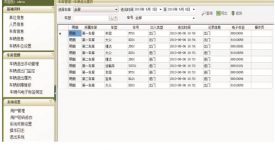
Vehicle management based on 433MHz+125KHz dual-frequency RFID
[ad_1]
Project background
Video recognition, 900MHz passive RFID, 2.4GHz active RFID and other technologies currently used in vehicle management, but these technologies require the installation of fixed equipment on the doorpost or the surrounding ground, which is expensive and easily affects vehicle traffic and the appearance of the door . The application of 433MHz+125KHz dual-frequency RFID technology not only has low equipment cost, but also can be buried in the ground, without affecting the appearance of the gate and vehicle traffic, and it has more advantages in the management of vehicle entry and exit with ultra-wide gates. Especially for the management of military vehicles, because the license plate is inconvenient to use video recognition, the dual-frequency RFID technology is more in line with actual needs!
Program features and advantages
1. It can be installed in the ground without affecting the aesthetics and vehicle traffic, and it has more advantages in the management of vehicle entry and exit with ultra-wide gates.
2. Allow vehicles to enter and exit in parallel, and allow some vehicles to enter the door at the same time that some vehicles leave the door without adding equipment.
3. Precise control can effectively prevent other vehicles from following; the boundary of the excitation zone is clear, the boundary error is about 0.3 meters, and the signal excitation distance between the exciter and the electronic tag is within 5 meters.
4. The electronic tag is usually in the standby state and emits signals only when it enters the excitation area. It has the characteristics of ultra-low power consumption, no radiation damage, and safe and reliable use.
5. 433MHz active RFID technology has the characteristics of strong penetration, strong diffraction, and long transmission distance. It is suitable for various complex environments. The reader at the receiving end only needs to be placed in the nearby duty room and connected to the computer.
6. In view of the penetrability and strong diffraction of 433MHz, the electronic tag can be adapted to a variety of special vehicles at the same time, which solves the problem of the recognition rate of some special vehicles by other technologies.
7. Effectively solve the shielding problem of vehicle explosion-proof metal mesh and car film in other solutions.
Scheme principle
The system consists of “monitoring computer”, “125KHz exciter”, “125KHz antenna”, “RFID reader” and “125KHz+433MHz dual-frequency RFID electronic tag (hereinafter referred to as electronic tag)”.
Install:
1. Paste the electronic label on the front windshield of the vehicle to realize one card per vehicle.
2. The exciter is buried in the middle of the gate box area, and the excitation antennas are buried on both sides of the gate in and out of the direction. The exciter is connected to the exciter through the buried wire tube. Power is obtained from the room).
3. Install “RFID reader” in the guard duty room near the gate (if there is no duty room at the gate, just install the RFID reader near the gate and connect to the computer through the network), and the guard duty room will distribute and install management computers system software.
working principle:
When a vehicle with an electronic tag enters the excitation area of the inner antenna or outer antenna of the 125KHz exciter, the electronic tag is awakened and sends a 433MHz radio frequency signal to the outside. The “RFID reader” obtains the electronic tag signal and transmits the information to the monitoring computer , The monitoring computer sends a track box control command to control the track box to open or close; after the vehicle leaves, the monitoring computer automatically judges the vehicle’s entry and exit status and records it according to the wake-up sequence of the electronic tag being activated by the inner or outer antenna.
Main function introduction
1. Application for departure
2. Vehicle approval
3. Query of vehicle in and out history records
4. Vehicle data query

Schematic diagram of vehicle entry and exit

[ad_2]



